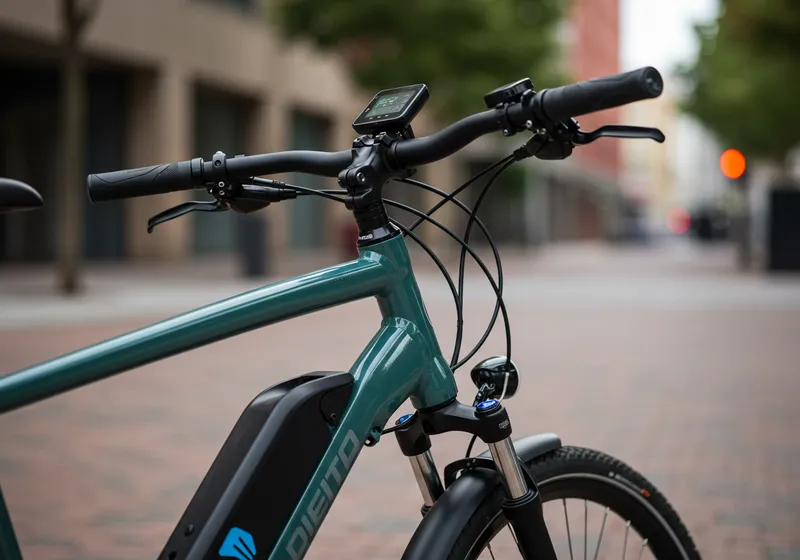Choosing between electric bikes and traditional bikes has become a common dilemma for riders of all backgrounds. Electric bikes (e-bikes) combine classic cycling design with a battery-powered motor, offering assistance with every pedal stroke. Traditional bikes, on the other hand, rely solely on your own effort, providing a pure cycling experience without added technology.
Understanding the pros and cons in this bike comparison helps you match your ride to your lifestyle, fitness goals, and commuting needs. Whether you’re weighing e-bikes vs traditional bikes for daily travel or weekend adventures, knowing the differences is key to making an informed choice.
Understanding Electric Bikes
Electric bikes are equipped with key components that distinguish them from traditional bikes:
- Motor: The e-bike motor is typically integrated into the rear or front wheel hub, or mounted centrally near the pedals. This motor provides pedal assistance, making it easier to ride uphill or against headwinds.
- Battery: E-bikes feature a rechargeable battery, usually lithium-ion, which powers the motor. Battery capacity varies, affecting how far you can travel on a single charge.
Pedal Assistance for a Smoother Ride
Electric bikes offer pedal assistance through sensors that detect your pedaling effort and adjust motor output accordingly.
This means:
- You experience less physical strain.
- Riding becomes smoother and more enjoyable.
- Ideal for individuals with health conditions or limited fitness.
Typical Speed Ranges
Most e-bikes are designed to reach speeds up to 20 mph, with some models capable of reaching 28 mph. These speeds can significantly reduce commuting time compared to traditional bikes, making e-bikes a practical choice for daily transportation.
Battery Range and Charging Times
Battery range varies depending on capacity and usage, typically allowing travel distances between 40 to 75 miles per charge. Expected charging times range from 2.5 to 8 hours.
When planning your journeys:
- Consider your commuting distance.
- Factor in charging availability.
- Plan for regular maintenance to ensure battery longevity.
By understanding these electric bike features, you can better appreciate their benefits and limitations, helping you make an informed decision when choosing between an e-bike and a traditional bike.
Understanding Traditional Bikes
Traditional bikes, known for their simple mechanics and complete reliance on human power, are a popular choice among cycling enthusiasts.
The main parts of traditional bikes include:
- Frame: Usually made from lightweight materials like aluminum, steel, or carbon fiber.
- Wheels and tires: Designed to provide stability and grip on different surfaces.
- Handlebars: Important for steering and control, available in various styles such as flat, drop, or riser bars.
- Pedals: The main connection between the rider and the bike, allowing power transfer through pedaling.
- Drivetrain: Comprising the chain, gears, and derailleurs that enable efficient energy transfer from the rider to the wheels.
- Brakes: Options include rim brakes, disc brakes, or coaster brakes for effective stopping power.
Human-Powered Cycling
One defining feature of traditional bikes is that they are completely powered by humans. Riders take on the challenge and pleasure of cycling without any help from motors. This type of cycling promotes physical fitness and encourages a stronger bond with nature.
Simple Maintenance
The design simplicity also applies to maintenance. Traditional bikes usually need less specialized care compared to electric bikes. Regular tasks such as lubricating the chain, adjusting brakes, and replacing tires are easy to do and generally inexpensive.
Overall, traditional bikes provide a dependable and budget-friendly choice for those who love cycling in its most genuine form.

Pros and Cons of Electric Bikes
Exploring the advantages of electric bikes reveals why they continue to gain popularity among both new and experienced cyclists.
E-Bike Benefits
- Ease of Riding with Motor Assistance: The built-in electric motor provides a noticeable boost, cutting down on the physical strain required for cycling. Hills, headwinds, and long commutes become less daunting. This makes e-bikes accessible to a wider range of riders—including older adults, individuals recovering from injury, or anyone who might find traditional cycling too strenuous.
- Longer Travel Distances Without Fatigue: E-bikes excel at extending your range. Many models deliver between 40–75 miles per charge, depending on battery size and terrain. Riders can confidently tackle longer commutes or weekend adventures without worrying about excessive exhaustion. For city dwellers looking for a sweat-free ride or rural explorers aiming to cover more ground, this advantage stands out.
- Sweat-Free Commutes: Arriving at work or social events without needing a change of clothes becomes possible when you let the motor handle the heavy lifting. This factor alone has led many commuters to switch from cars or public transit to e-bikes.
Disadvantages of Electric Bikes
- Higher Upfront Purchase Cost: Compared to traditional bikes, e-bikes require a bigger investment up front. Most quality models start around $1,000 and can stretch up to $10,000 for premium builds with advanced batteries and integrated technology. The price tag often surprises first-time buyers considering an upgrade.
- Heavier Weight Impacts Portability: With added components like the motor and battery, most e-bikes weigh significantly more than their pedal-powered counterparts—often in the 20–25 kg range. Carrying an e-bike upstairs or loading it onto public transport can be challenging. When battery power runs out, manual pedaling also feels more laborious due to this extra weight.
“Electric Bikes vs Traditional Bikes: Pros and Cons” often hinges on these factors—the ease of riding and extended range balanced by higher costs and heavier frames.
Maintenance is another consideration. E-bikes feature more complex electronics and specialized parts that might require professional servicing instead of DIY fixes common with regular bikes. For some riders, this factor influences daily usability as much as cost or weight does.
These upsides and drawbacks set the stage for a balanced decision when comparing both categories side by side.
Pros and Cons of Traditional Bikes
Traditional bikes stand out for their simplicity and straightforward design, making them a favorite among cyclists who value ease of use and minimal upkeep. The advantages of traditional bikes are clear, especially when it comes to portability and urban practicality.
Advantages of Traditional Bikes
- Lightweight Construction: Without heavy batteries or motors, most standard models weigh 10–15 kg. This makes carrying a bike up stairs or onto public transit much less of a hassle. In cities where bike storage is limited, this feature becomes essential—you can easily lift or maneuver your bike into small apartments, offices, or crowded racks.
- Accessibility Through Price: Traditional bikes come with a lower initial purchase price compared to electric models. Quality entry-level road or hybrid bikes often start below $500, making cycling accessible to students, families, and anyone looking for affordable transportation.
- Simplicity in Maintenance: Fewer moving parts mean fewer things that can go wrong. Routine maintenance—like lubricating the chain or adjusting brakes—is straightforward and doesn’t require specialized knowledge or tools. This simplicity reduces ongoing costs over the lifetime of the bike.
- Fully Human-Powered Experience: Every ride offers direct engagement with the road and a pure physical challenge. Many cyclists prefer this connection—it’s ideal for those seeking exercise, skill development, or simply the joy of self-powered travel.
The absence of electronics eliminates worries about battery range or charging times. You set your pace and distance without technological limits.
Limitations of Traditional Bikes
Traditional bikes do have limitations—long distances and steep hills demand more physical effort—but their lightweight frames and mechanical reliability keep them popular for short commutes, recreation, and fitness routines alike.

Comparing Key Factors Between Electric and Traditional Bikes
When considering the purchase price, electric bikes typically come at a higher cost compared to traditional bikes. An e-bike can range from $1,000 to $10,000 depending on the model, brand, and features. In contrast, traditional bikes generally cost between $200 and $1,500, making them accessible to a larger audience.
Long-term Operational Expenses
Maintenance Costs
- Electric Bikes: They require specialized parts and electronics that might need expert maintenance. Battery replacements and motor servicing can add to the expenses.
- Traditional Bikes: Simpler mechanics often mean lower maintenance costs. Basic repairs and part replacements are usually cheaper.
Energy Expenses
- Electric Bikes: Charging the battery regularly incurs electricity costs. Recharge times range from 2.5 to 8 hours.
- Traditional Bikes: No energy costs as they rely entirely on human power.
Durability and Lifespan
- Electric Bikes: The lifespan of an e-bike’s battery typically ranges from 3 to 5 years before requiring replacement.
- Traditional Bikes: With proper care, traditional bikes can last for decades without significant additional costs.
Assessing these factors is crucial for making an informed decision based on your budget and long-term financial considerations.
Making the Right Choice Based on Individual Needs
Choosing between electric and traditional bikes involves evaluating several personal factors.
Fitness Level and Health Considerations
Your fitness level and health considerations play a crucial role in this decision. If you have limited physical stamina or health conditions that restrict strenuous activity, an electric bike can provide the necessary assistance to make cycling enjoyable and feasible. The motor support reduces the effort required to pedal, enabling you to cover longer distances without fatigue.
Budget Constraints
Budget constraints are another important aspect when deciding between an e-bike and a traditional bike. Electric bikes generally come with a higher upfront cost, ranging from $1,000 to $10,000, which might be a barrier for some buyers. Traditional bikes are typically more affordable, making them accessible to a larger audience.
Willingness to Invest Upfront
Consider your willingness to invest upfront in either option. While electric bikes require a significant initial investment, they offer long-term benefits such as ease of commuting and extended travel range. On the other hand, traditional bikes have lower purchase prices but may demand more physical effort during rides.
Evaluating these factors helps ensure you choose a bike that aligns with your individual needs, whether it’s for daily commuting, recreational use, or maintaining fitness levels. Assessing your priorities in terms of health and budget will guide you towards making the right choice between electric and traditional bikes.
Conclusion
Choosing between an electric bike and a traditional bike depends on your personal lifestyle factors. Consider your commuting habits, the type of terrain you navigate, and your environmental values to make a well-informed decision.
- Commuting Patterns: If you often travel long distances or encounter difficult terrains, electric bikes provide motor assistance and greater range, making your journey more comfortable and less physically demanding.
- Environmental Values: While both options are eco-friendly, traditional bikes produce no emissions and require simpler maintenance, aligning with a minimalist approach to being environmentally conscious.
Each type of bike has its own advantages. The right choice depends on your specific needs, whether you value convenience and longer trips with electric bikes or simplicity and complete physical exercise with traditional bikes.
Understanding the pros and cons of each option will help you choose the best bike for your lifestyle.




